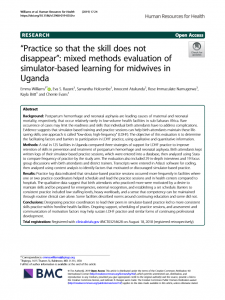
Background
Postpartum hemorrhage and neonatal asphyxia are leading causes of maternal and neonatal mortality, respectively, that occur relatively rarely in low-volume health facilities in sub-Saharan Africa. Rare occurrence of cases may limit the readiness and skills that individual birth attendants have to address complications. Evidence suggests that simulator-based training and practice sessions can help birth attendants maintain these life-saving skills; one approach is called “low-dose, high-frequency” (LDHF). The objective of this evaluation is to determine the facilitating factors and barriers to participation in LDHF practice, using qualitative and quantitative information.
Methods
A trial in 125 facilities in Uganda compared three strategies of support for LDHF practice to improve retention of skills in prevention and treatment of postpartum hemorrhage and neonatal asphyxia. Birth attendants kept written logs of their simulator-based practice sessions, which were entered into a database, then analyzed using Stata to compare frequency of practice by the study arm. The evaluation also included 29 in-depth interviews and 19 focus group discussions with birth attendants and district trainers. Transcripts were entered in Atlas.ti software for coding, then analyzed using content analysis to identify factors that motivated or discouraged simulator-based practice.
Results
Practice log data indicated that simulator-based practice sessions occurred more frequently in facilities where one or two practice coordinators helped schedule and lead the practice sessions and in health centers compared to hospitals. The qualitative data suggest that birth attendants who practiced more were motivated by a desire to maintain skills and be prepared for emergencies, external recognition, and establishing a set schedule. Barriers to consistent practice included low staffing levels, heavy workloads, and a sense that competency can be maintained through routine clinical care alone. Some facilities described norms around continuing education and some did not.
Conclusions
Designating practice coordinators to lead their peers in simulator-based practice led to more consistent skills practice within frontline health facilities. Ongoing support, scheduling of practice sessions, and assessment and communication of motivation factors may help sustain LDHF practice and similar forms of continuing professional development.